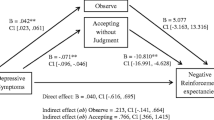Abstract
Patients who continue to use tobacco following treatment for head and neck cancers are at a greater risk for cancer recurrence and earlier mortality. This study examined the unique effects of public and private self-consciousness and negative affect on smoking behavior in a sample of 40 patients with cancers of the head and neck. Measures of public and private self-consciousness and negative affect were administered and assessments of past and current smoking behavior were obtained. Only public self-consciousness was a significant predictor of continued smoking following oncologic treatment. Specifically, individuals with low levels of public self-consciousness were nearly 13 times more likely to continue smoking compared to those with relatively higher levels of public self-consciousness. This pattern is interpreted in the context of previous theorizing that suggests individuals high in public self-consciousness are more likely to discontinue habitual behavior that is perceived as socially undesirable or incorrect.
Similar content being viewed by others
References
Shapiro P, Kornfeld D: Psychiatric aspects of head and neck cancer surgery.Psychiatric Clinics of North America. 1987,10:87–100.
Ostroff JS, Jacobsen PB, Moadel AB, et al.: Prevalence and predictors of continued tobacco use after treatment of patients with head and neck cancer.Cancer. 1995,75:569–576.
Shottenfeld D: Alcohol as a co-factor in the etiology of cancer.Cancer. 1979,43:1962–1966.
Andre K, Schraub S, Mercier M, Bontemps P: Role of alcohol and tobacco in the etiology of head and neck cancer: A case-control study in the Doubs region of France.European Journal of Cancer. 1995,31B:301–309.
Moore C: Cigarette smoking and cancer of the mouth, pharynx, and larynx.Journal of the American Medican Association. 1971,218: 553–558.
Silverman S, Greenspan D, Gorsky M: Tobacco usage in patients with head and neck carcinomas: A follow-up study on habit changes and second primary oral/orpharyngeal cancer.American Dental Association. 1983,106:33–35.
Des Rochers C, Dische S, Saunders MI: The problem of cigarette smoking in radiotherapy for cancer in the head and neck.Clinical Oncology. 1992,4:214–216.
Stevens MH, Gardner JW, Parkin JL, Johnson LP: Head and neck cancer survival and life-style change.Archives of Otolaryngology. 1983,109:746–749.
Christensen AJ, Moran PJ, Ehlers SL, et al.: Smoking and drinking behavior in patients with head and neck cancer: Effects of behavioral self-blame and perceived control.Journal of Behavioral Medicine. 1999,22:407–418.
Ingram RE: Self-focused attention in clinical disorders: Review and conceptual model.Psychological Bulletin. 1990,107:156–176.
Pyszcynski T, Greenberg J: Self-regulatory perseveration and the depressive self-focusing style: A self-awareness theory of reactive depression.Psychological Bulletin. 1987,102:122–138.
Smith TW, Ingram RE, Roth DL: Self-focused attention and depression: Self-evaluation, affect, and life stress.Motivation and Emotion. 1985,9:381–389.
Carver CS, Sheier MF: Functional and dysfunctional responses to anxiety: The interaction between expectancies and self-focused attention. In Schwarzer R (ed), Self-Related Cognitions in Anxiety and Motivation. Hillsdale, NJ: Lawrence Erlbaum Associates, Inc., 1986, 111–141.
Sarason IG: Test anxiety, worry, and cognitive interference. In Schwarzer R (ed), Self-Related Cognitions in Anxiety and Motivation. Hillsdale, NJ: Lawrence Erlbaum Associates, Inc., 1986, 19–33.
Hull JG: A self-awareness model of causes and effects of alcohol consumption.Journal of Abnormal Psychology. 1981,90:586–600.
Fenigstein A, Scheier MF, Buss AH: Public and private self-consciousness: Assessment and theory.Journal of Consulting and Clinical Psychology. 1975,43:522–527.
Duval S, Wicklund RA: A Theory of Objective Self-Awareness. New York: Academic, 1972.
Becker DM, Young DR, Yanek LR, et al.: Smoking restriction policy attitudes in a diverse African American population.Social Psychology. 1998,7:319–342.
Porcellato L, Dugdill L, Springett J, Sanderson FH: Primary schoolchildren’s perceptions of smoking: Implications for health education.Health Education Research. 1999,14:71–83.
Gilbert GR, Hannan EL, Lowe KB: Is smoking stigma clouding the objectivity of employee performance appraisal?Public Personnel Management. 1998,27:285–300.
Covey LS, Glassman AH, Stetner F: Cigarette smoking and major depression.Journal of Addictive Diseases. 1998,17:35–46.
Watson D, Clark LA, Tellegen A: Development and validation of brief measures of positive and negative affect: The PANAS Scales.Journal of Personality and Social Psychology. 1988,54:1063–1070.
Clark LA, Watson D: Tripartite model of anxiety and depression: Psychometric evidence and taxonomic implications.Journal of Abnormal Psychology. 1991,100:316–336.
SPSS Inc.: SPSS Advanced Statistics 6.1. Chicago: SPSS Inc., 1994.
Dropkin MJ, Malgady RG, Scott DW, Oberst MT, Strong EW: Scaling of disfigurement and dysfunction in postoperative head and neck patients.Head and Neck Surgery. 1983,6:559–570.
Gritz ER, Carr CR, Rapkin D, et al.: Predictors of long-term smoking cessation in head and neck cancer patients.Cancer Epidemiology, Biomarkers, and Prevention. 1993,2:261–270.
Jarvis MJ, Tunstall-Pedoe H, Feyerabend C, Vesey C, Saloojee Y: Comparison of tests used to distinguish smokers from non-smokers.American Journal of Public Health. 1987,77:1435–1438.
Liebling BA, Seiler M, Shaver P: Self-awareness and cigarette-smoking behavior.Journal of Experimental Social Psychology. 1974,10:325–332.
Wicklund RA, Duval S: Opinion change and performance facilitation as a result of objective self-awareness.Journal of Experimental Social Psychology. 1971,7:319–342.
Author information
Authors and Affiliations
Corresponding author
About this article
Cite this article
Raichle, K.A., Christensen, A.J., Ehlers, S. et al. Public and private self-consciousness and smoking behavior in head and neck cancer patients. ann. behav. med. 23, 120–124 (2001). https://doi.org/10.1207/S15324796ABM2302_6
Issue Date:
DOI: https://doi.org/10.1207/S15324796ABM2302_6




